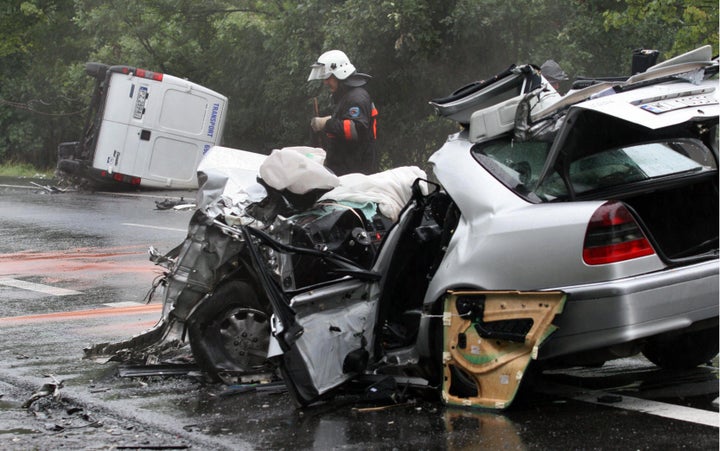
A couple of weeks ago, before the publication of Superfreakonomics, the follow up to the bestselling Freakonomics by New York Times "Freakonomics" columnists, we were contacted by the publisher to get early word out. We posted a video and immediately began hearing from the scientific community that their work had been badly misrepresented to support a position on not reducing carbon emissions to reduce global warming. We posted a follow up piece, warned the publisher and because of that, a response was forced on the "Freakonomics" blog.
Before the controversy, we were given an excerpt to publish in anticipation of the book's publication date and at the time we decided not to run it. We were hoping they'd give us an excerpt from the chapter on global warming that had come into question, but no such luck. We were given an excerpt on whether or not it was safer to drive drunk than to walk drunk. The third possibility of getting a cab is mentioned only parenthetically, but if we're only supposed to think through a dualistic problem, then the third possibility messes up the author's "either/or" scenario. We wonder if you think the upshot is a cheap shot or if these statistics are relevant. And we would also like to know what Mothers Against Drunk Driving might have to say about this. Let us know what you think by voting below:
From Superfreakonomics by Steven Levitt and Stephen Dubner:
Imagine you've gone to a party at a friend's house. He lives only a mile away. You have a great time, perhaps because you drank four glasses of wine. Now the party is breaking up. While draining your last glass, you dig out your car keys. Abruptly you conclude this is a bad idea: you are in no condition to drive home.
For the past few decades, we've been rigorously educated about the risks of driving under the influence of alcohol. A drunk driver is thirteen times more likely to cause an accident than a sober one. And yet a lot of people still drive drunk. In the United States, more than 30 percent of all fatal crashes involve at least one driver who has been drinking. During the late-night hours, when alcohol use is greatest, that proportion rises to nearly 60 percent. Overall, 1 of every 140 miles is driving drunk, or 21 billion miles each year.
Why do so many people get behind the wheel after drinking? Maybe because--and this could be the most sobering statistic yet--drunk drivers are rarely caught. There is just one arrest for every 27,000 miles driven while drunk. That means you could expect to drive all the way across the country, and then back, and then back and forth three more times, chugging beers all the while, before you got pulled over. As with most bad behaviors, drunk driving could probably be wiped out entirely if a strong-enough incentive were instituted--random roadblocks, for instance, where drunk drivers are executed on the spot--but our society probably doesn't have the appetite for that.
Meanwhile, back at your friend's party, you have made what seems to be the easiest decision in history: instead of driving home, you're going to walk. After all, it's only a mile. You find your friend, thank him for the party, and tell him the plan. He heartily applauds your good judgment.
But should he? We all know that drunk driving is terribly risky, but what about drunk walking? Is the decision so easy?
Let's look at some numbers, Each year, more than 1,000 drunk pedestrians die in traffic accidents. They step off sidewalks into city streets; they lie down to rest on country roads; they make mad dashes across busy highways. Compared with the total number of people killed in alcohol-related traffic accidents each year--about 13,000--the number of drunk pedestrians is relatively small. But when you're choosing whether to walk or drive, the overall number isn't what counts. Here's the relevant question: on a per-mile basis, is it more dangerous to drive drunk or walk drunk?
The average American walks about a half-mile per day outside the home or workplace. There are some 237 million Americans sixteen and older; all told, that's 43 billion miles walked each year by people of driving age. If we assume that 1 of every 140 of those miles are walked drunk--the same proportion of miles that are driven drunk--then 307 million miles are walked drunk each year.
Doing the math, you find that on a per-mile basis, a drunk walker is eight times more likely to get killed than a drunk driver.
There's one important caveat: a drunk walker isn't likely to hurt or kill anyone other than her- or himself. That can't be said of a drunk driver. In fatal accidents involving alcohol, 36 percent of the victims are either passengers, pedestrians, or other drivers. Still, even after factoring in the deaths of those innocents, walking drunk leads to five times as many deaths per mile as driving drunk.
So as you leave your friend's party, the decision should be clear: driving is safer than walking. (It be even safer, obviously , to drink less, or to call a cab.) The next time you put away four glasses of wine at a party, maybe you'll think through your decision a bit differently. Or, if you're too far gone, maybe your friend will help sort things out. Because friends don't let friends walk drunk.